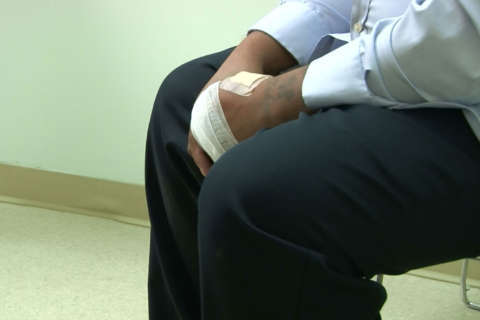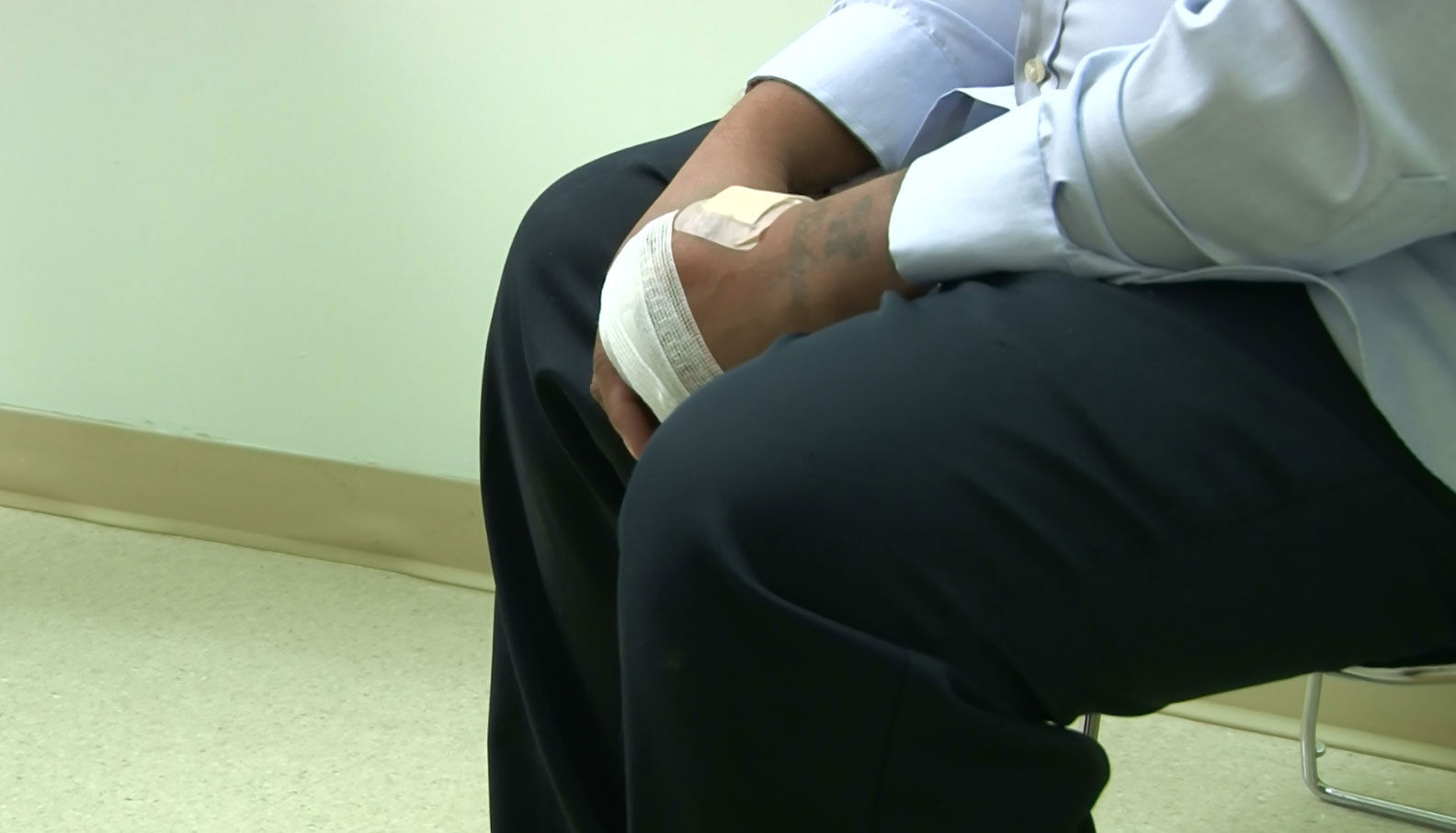
WASHINGTON — It wasn’t until Julian held a gun to a man’s head that he realized he needed to leave the gang life.
“Something held me back” just as he was about to pull the trigger, he says now. “A switch was turned off. I felt like I didn’t need to be there, and I started seeing things very different.”
That was in 1999. Julian didn’t realize it at first, but says he now knows “God was there with me.”
He now has a job and a family and goes to school at night, and hasn’t been involved with gang activity for many years. But one aspect of those days remains — the tattoos he got to show solidarity with the gang.
That’s why Julian made his first visit to the free gang-tattoo removal clinic at the Greater Prince William Community Health Center on a recent Tuesday night — to begin the process of removing the signs of his earlier life.
Sitting with bandages on his hands after a removal session, he said, “With what you got on your skin, you could end up in a situation where you don’t want to be,” he said. “You could put your life at risk.”
When Julian announced he was leaving the gang, some of the members told him they’d kill him if they saw him around again. He had to avoid places where his old gang — and rival gangs — would hang out. He still lives in the same area he ran in, but he’s been inactive for so long most current gang members wouldn’t remember him.
“And if they were to ask me, I could lie and be like, ‘Well, I’m not.’ And then they wouldn’t know — unless they were to see my tattoos.”
Removing the tattoos is Julian’s way of wiping his slate clean — with other gang members and with society. He remembered going to a house to buy a piano for his daughter, and finding out that the wife of the man selling the piano was a U.S. marshal. “And I’m over there trying to hide my hands.”
WTOP observed a recent tattoo-removal session under a few rules: The names of the subjects in this report have been changed. No photos or video of faces, or of the gang tattoos; no mention of which gang a client was in. Richard Buchholz, who runs the program, hovers over each interview, making sure nothing is divulged that could identify anyone.
‘You have to change your life’
Buchholz, a retired Anaheim, California, police sergeant, started the program in 2008 and has been with the Northern Virginia Gang Response Intervention Team since 2005. He said being on the prevention side of the gang issue, rather than the law enforcement side, is gratifying — and effective.
About 40 former gang members have gotten tattoos removed over the years, he said, and there are about eight current clients. To get into the program, applicants have to complete 50 hours of community service, be free of any gang involvement for at least six months and not have any pending charges against them. Juveniles must have passing grades in school; adults must be working, in a vocational program or seeking work.
“You have to change your life first,” said the doctor who performs the laser treatment on this recent evening. She said most of the clients are between 14 and 22, with a few in their 30s.
The only cost for the program is the laser that removes the tattoos. The supplies and the use of the building are donated; the doctors and nurses who do the work are volunteers.
A few clients have dropped out of the program over the years, but of those who complete it, “nobody’s reoffended,” Buchholz said. “I’ve checked as best I can.” Several alumni, he said, have helped his task force by talking with youth groups and spreading awareness about the dangers of gangs. “They’re really giving back to the community,” Buchholz said.
The doctor said that she sees some clients for years; they joined gangs in school and now have families. She adds, “We used to have a uniformed, armed policeman here. But we don’t feel that we need it. We all leave together, and we work together, but we’re comfortable with these people. They’re good community citizens.”
A painful process
In the treatment room where the tattoos are removed, the laser makes a loud, metallic clack as it works — a sound that dominates conversation in the rest of the clinic. It appears as a series of small balls of light that shoot from the tip of the instrument onto the patient’s skin in rapid succession — bright even from behind the protective glasses everyone in the room has to wear.
Each treatment lasts five to 20 minutes, depending “on the patient and how well they’re tolerating [pain] on that particular night,” Buchholz said. One former gang member, a teenager, lasted about 13 minutes. The room heats up from the machinery; on his arm, the laser takes a succession of white divots out of his skin. The affected areas rise up like a scar, then turn bloody. The laser beam is only two millimeters wide, the doctor explains, so she’s got to go over the lines several times.
Hector said, “It’s painful, but the number-one thing I do is prepare myself to think I’m not going to feel pain. … In my mind I’m thinking of why I’m doing this, and — I just have to do it.”
Hector looks to be in his 30s; he joined a gang at 15. He was raised in the Salvadoran community in Arlington, and “that’s all you saw. I pretty much grew up in it.” He said he went to jail a few times, “and just saw where everybody was headed. Which is getting deported — and a few of them are not here anymore.”
When his first daughter was born, “I didn’t take things how I should have,” he said, but he eventually left the gang at 26 for the sake of his family: “Over time it kind of grew into me that I needed to step up and be there for her as a man.” He now calls himself “a house man. … If I go out, it’s with my family.”
She’s getting older, Hector said, and “the way the internet is now, it’s so easy to find out what everything is. And my [tattoos] are pretty self-explanatory. My fear was her just going into Google and seeing a person I’m not anymore.”
Tattoo removal isn’t a quick process; he’s been coming for four years, and this is roughly his 30th treatment. A nurse explains the routine for avoiding infection over the next few days, calling the laser site “a wound because this is considered a wound.”
The teenager doesn’t change facial expression as he undergoes the treatment; later, the doctor says he was hit with the laser a total of 5,200 times.
The doctor said the clients will say it doesn’t hurt. She adds that they’re lying: “It hurts like hell.”
‘I don’t have to explain to anyone’
Julian had been in a gang since he was 17, 10 years after coming with his family from El Salvador. “Issues at home” and “a lot of negativity” led him away from his family and into associations with “different kids.”
The process was a gradual one: “You become prey to these friends that are part of this gang — because they can do this for you; they can do that for you. And then you just feel, you know, like somebody cares. And then from there on it’s downhill. Because then you really don’t know what you [got] into.”
He added, “You start lying, cheating, robbing. And you work your way” — he’s about to say “up” – “down, so to speak.”
Asked what he’d tell a kid in the same broken family situation he was in, and thinking of joining a gang, Julian said he’d tell him to “think very hard about where he wants to go in life, and how far he wants to get. … A lot of my friends are dead and gone — never made it to my age.”
Having the perspective to think about others is the critical thing: “When you’re young … you don’t think about ‘If I have a child, what’s going to happen? If I have a woman, what’s going to happen?’ Or ‘If I keep going down this path, where am I going to end up? If I keep going down this path, is my family gonna be OK? My sisters? My dad? My mom?’ Any retributions, you gotta think about all of that.
“Once you get in the gang … it involves your family. Nine times out of 10, if they can’t get you, they come after your family. And they don’t deserve that.”
When his tattoos are gone, Julian said, “I don’t have to explain to anyone. … You’re not put in [a situation of] ‘You’re one of them.’ No — I’m sorry, but that person died a long time ago. I don’t think that way; I don’t walk that way. I don’t partake in that no more.”









